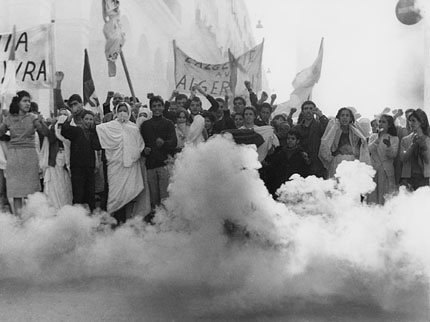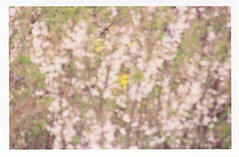

 Syndromes and a Century by
Syndromes and a Century by Apichatpong “Joe” Weerasethakul

Metaphysics rule the day in this evocative, abstract meditation on love, medicine, and the evolution of modern living by Thai auteur Apichatpong “Joe” Weerasethakul. Set at once in the present, the future, and in memories of the past…at a quaint countryside hospital as well as its monolithic city counterpart, the film observes the everyday ticks in the lives of patients and caregivers: a dentist who coos Thai Country ballads, a monk with suppressed longings for a career as a DJ, a physician so smitten with his coworker he proposes to her, and a doctor so riveted by the sway of nature she’s indifferent to the possibility of romance.
The film opens twice with a female physician questioning a young doctor recently added to the staff. Staring directly into the camera, the pair exchanges a series of questions and answers identical in the films two halves save the young doctor’s stated position. In the first half or chapter, a film set in the countryside amongst sun, open-air rooms and fields of tall grass, the young doctor has left the army and come to serve as a general physician to the rural dwellers of Thailand. In the film’s second chapter, the young doctor arrives at the expansive Bangkok medical center as a pharmacist, having switched his studies while in med-school.
The difference between the doctor’s practice in the film’s two halves is auspicious for the attention “Joe” pays the sequence. As with most of
Syndromes and a Century, events dramatized in the film’s intimate, naturalized first chapter are mirrored to some degree in its austere, sterile second chapter. In the first chapter, a physician’s romantic aspirations for his coworker sends the film on a journey through flashbacks, a sequence so stuffed with amorous innocence the dense
Syndromes appears to float off the screen. By contrast, in the second chapter, the considerably blunted romantic dalliances feature a doctor so turned on by his female counterpart he reaches a visible erection. Similarly, a singing dentist and his patient—a soft-spoken young monk—forge a friendship so tender it nearly eclipses their boundaries of religion and profession in chapter one. In chapter two, the same characters fail to connect, the monk’s modernized angst echoing the dichotomy between the examination room’s décor in the two chapters. Even a solar eclipse impeccably photographed in the early goings gets its reprise in the form of a fume guzzling air duct in the final stanza, the camera isolating the black ovular mouth of the duct against a searing white light to create an imposing replication of the mystical phenomenon. As well, where the first chapter winds its way farther into the wilderness, culminating with the romantically disinclined doctor journeying out to the orchid farm of her innocent suitor, the second descends further into a surrealist bent, plunging deeper and deeper into the bleak recesses of a mega medical center.
This narrative duplicity is the film’s most obvious trait, a pattern lending itself to quick commentary on the relationship between similar sequences in the two chapters as a reflection of the effect disparate environments can pose on one’s spiritual self. However, to leave an analysis of the film at that is to deny “Joe” due praise for his exemplary employ of craft. The wind talks and the sky glows in the first chapter just as the walls and corridors of the second skulk along amidst ominous atmospherics. At any point
Syndromes and a Century could be isolated into a five second loop and lose none of its potency. “Joe” projects artistic intent into every frame of the film.
Western cinema has done film art the injustice of subverting it to narrative. “Joe” thrashes that concept. While the sequences themselves progress in linear fashion, the scenarios moving from point A to point B as in real life, the thematic impart of the work derives much less from the “what, when, where, why and how” of the piece than from a multi-disciplined analysis of the juxtaposition of the elements at play. Much like visual or performance art,
Syndromes and a Century requires a contextualization that reaches beyond the information found in the film itself. An understanding of “Joe”—his history and his motivations behind making the film as well as a familiarity with the works he's completed prior—is essential in cultivating an analysis. Just as a painting, sculpture or lyric is embellished by the nature of its origin and the intent of its author, its impart continuously evolving in light of the observer’s understanding of those elements, so too does Joe’s cinema (as does any cinema not treated as the indifferent pictorial presentation of a narrative).
As Jonathan Rosenbuam wrote of Claire Denis in his analysis of
Beau Travail,
Syndromes and a Century proves Apichatpong “Joe” Weerasethakul is capable of poetry well beyond the range of most modern or past filmmakers. This film is a work of art.







































